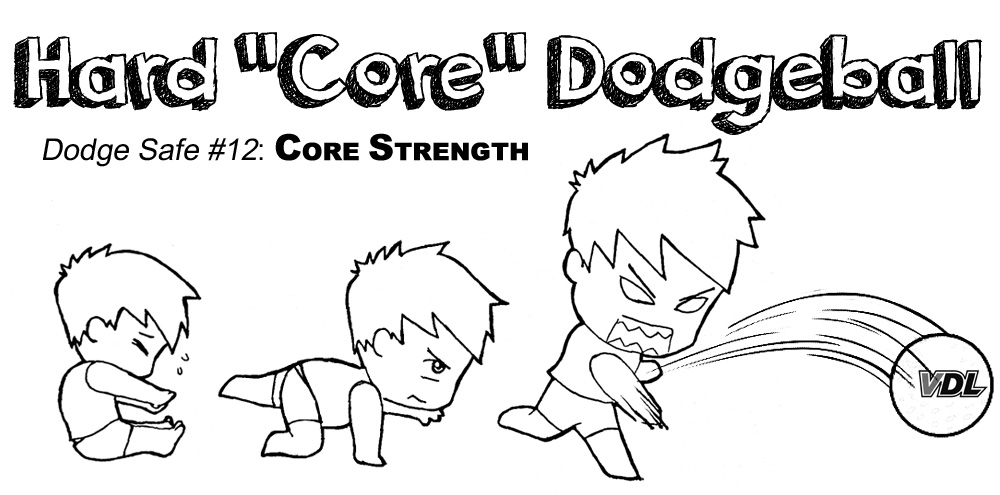Dodge Safe #12: The “Core” to a Stronger Throw
Posted on March 09, 2014 at 10:47 pm |
One of the keys to possessing a fast and powerful throw is to have rotator cuff strength; the other key is to have adequate core strength. Everyone’s probably heard of the core, but what is it really and how can we strengthen it?
I have a six pack, is that the core?
No. A common misconception is that the core is simply the six pack muscles, otherwise known as the Rectus Abdominus.
In general, the core refers to the trunk muscles that lie underneath the six pack muscles. One of these abdominal muscles is called the Transversus Abdominus. It is the deepest abdominal muscle and wraps around the entire trunk like a weight belt.
Over the Transversus Abdominus, there are two abdominal muscles on each side called the Internal Oblique and the External Oblique. They are responsible for rotating or twisting your trunk and are especially important in generating power when throwing a dodgeball.
Figure A. The core muscles. Adapted from http://morganmassage.com/2012/10/30/7-exercises-that-will-strengthen-your-core-and-save-your-back/
Surprisingly, there is no one universal definition for core muscles. Some physiotherapists, kinesiologists, or personal trainers may also include the low back, hip, and pelvic muscles as part of the core.
A/N: Personally, I use the term “core muscles” to describe the abdominal muscles. The low back, hip, and pelvic muscles contribute and work in tandem with the core as all these muscles are interconnected in one way or another. These muscles contract as a unit whenever we perform a full-body movement such as throwing.
Functions of the core
- Stabilize your spine to prevent injury. As mentioned before, the Transverse Abdominus muscle wraps around the trunk like a weight belt so when it contracts and tightens, the pressure created within the abdomen stabilizes the spine.
- Transfer forces between the upper and lower body (Kuhland, n.d.). In the throwing motion, the lower extremity and the core generate and then transfer their energy to the upper extremity to propel the ball towards its target (Seroyer et al., 2010).
Figure B. Acting as a connection, the core transfers the energy generated from the lower body to the upper body. Adapted from http://www.coreconcepts.com.sg/mcr/weve-heard-so-much-of-the-core-what-about-the-slings/
Core Exercises
These are not your typical sit-ups or crunches. The following exercises aim to strengthen both core muscles as well as the low back, hip, and pelvic muscles.
1. Bird-Dog
Figure C. Bird-Dog Exercise. Adapted from http://www.builtlean.com/2012/02/27/bird-dog-exercise/
-
Start by being on all fours with hands under your shoulders and knees under your hips.
-
While keeping your back straight and hips leveled, raise your left arm and your right leg until it is in line with your torso. Try to raise your arm and leg in 3 seconds. The slower you raise your arm and leg, the harder it is as more stability is required from your core.
-
Hold the end position for 2-3 seconds.
-
Slowly return to the starting position and repeat with opposite arm and leg.
-
Try 15 repetitions for each side.
2. Woodchop
Figure D. Woodchop Exercise. Adapted from http://www.sweatlikeapig.com/2012/12/14/my-favourite-ab-exercises/
-
Starting with your knees shoulder-width apart and knees slightly bent, hold the resistant band or a weighted medicine ball or a dumbbell (5-10 lbs) overhead and to the side
-
As you squat, slowly pull the band or bring the ball/dumbbell diagonally across your body towards your opposite hip
-
Make sure not to over-twist your trunk; rotate in a comfortable range of motion
-
Return to starting position
-
Try 10-15 repetitions for each side
Carolyn Tam is a registered physiotherapist currently working in the Lower Mainland. She completed her Master of Physical Therapy degree at the University of British Columbia after graduating from UBC with a Bachelor of Human Kinetics.
References
Kuhland, J. (n.d.). Do you know what your core really is and what it does?. Retrieved on Feb 27, 2014 from http://breakingmuscle.com/mobility-recovery/do-you-know-what-your-core-really-is-and-what-it-does.
Seroyer, S.T., Nho, S.J., Bach, B.R., Bush-Joseph, C.A., Nicholson, G.P., Romeo, A.A. (2010). The Kinetic Chain in Overhead Pitching. Sports Health. 2(2): 135–146.





